Show of hands…how many of you folks dabbled in creating your own space missions in whatever pop-culture medium you happened to like at the time? I myself had a very bad addiction to the “X-Wing” series on the PC, followed by “TIE Fighter” and later, “X-Wing vs. TIE Fighter”. The latter of the three even had a downloadable mission editor which I relentlessly picked at. “Gunship: First Strike!” reminds me a little of those days, as I didn’t find myself focused on any one ship, but on the larger picture at hand. In this particular game, players will be given three different types of ships and will be endeavouring to outmaneuver the other in deadly space combat. Before we start priming the turrets and charging the shields, I’d like to thank Steve Wood from Escape Pod Games for providing me with a free review copy.
Components – (Core Game Only)
Ship & Wing Boards – Rather than have a centralized board on which everyone will be participating, each player will receive various ship & wing boards for the purpose of tracking individual damage, weapons, and so on.
Cards – There is a set of nineteen cards for each of the player colors (up to four) and eighty-two cards in the main deck.
Fighter Tokens – These tokens track destroyed fighter ships. Each player has twelve fighter ships (four squads of three ships) and thus, will receive twelve tokens before the game starts.
Dice – The game includes one eight-sided die, two twelve-sided dice, and four six-sided dice. The eight-sided die determines hit location during battles, the twelve-sided dice are used to track an individual player’s shield/hull strength for their carrier, and the six-sided dice display various icons that determines damage (among other things).
As a result of stretch goals being met in the Kickstarter campaign, extras were included with the core set. They include new deck cards, unit tokens, upgrades & crew cards, extra dice, and a separate manual explaining the extra rules / options players have available to them.
Setup & Gameplay
Editor’s Note: It’s worth noting right off the bat that there is a lot of specific “if-then” rules that apply to this game and as such, I’ll be summarizing the setup and gameplay to streamline the review process. To see more detailed information on a specific topic, please refer to the manual I linked at the end of this section.
The setup is fairly simple with each player receiving an equal share of boards & tokens. Each player also gets a deck specific to their color, separating out the cards based on their type (shields, armor, & weapons). The main deck of cards (the one containing eighty-two cards) is shuffled and will be utilized by all of the players during the game. Players will also be allowed to customize their gunship with weapons for their pods and wings, as well as choose which components they want to line with armor via the armor cards. After the game setup is complete, each player gets five cards from the main deck to form their hand.
To summarize the game, each player will have a carrier, gunship, and squadron of fighters. The carrier acts as the mothership which MUST be protected at all costs. Whoever loses their carrier, loses the game. The gunship is the best equipped to attack the carrier and is the most flexible of the three ships. It can move back and forth between zones (friendly, center, enemy) and be customized with a few different weapon types. Fighters play more of a support role and assist with the defense of their gunship, though they can attack if you wish them to. Each of these three ship types have special rules in regards to who they can attack and how they respond to being attacked.
It’s also worth mentioning that there are smaller boards / cards that represent the gunships’ and fighter squadrons’ relative locations on the battlefield. Between the carrier boards is a “center zone” where the smaller gunship and fighter boards can meet to initiate combat. These smaller cards can retreat back to their “friendly zone” (their carrier board) or advance into the “enemy zone” (the enemy carrier board). Players will be moving these two cards back and forth at will, depending on their needs and what actions they’d like to take.
The game is played over a series of rounds, with each round observing the following phases:
A) Initiative Phase – Each player rolls to see who goes first during that round.
B) Carrier Phase – Each player draws one card from the main deck to simulate the part of the battle where carriers bombard each other with cannon fire. Damage is applied to the carriers accordingly, via the carrier board.
1) Draw – The current player draws up to five cards.
2) Fighter Phase – Fighters have unlimited action points and can move freely across all zones until they encounter an enemy squadron. When this happens, a mandatory dogfight ensues. While they can’t attack the enemy carrier, they can make strafing runs at the enemy gunship when the situation allows it.
3) Gunship Phase – Gunships are considered the “hero” class of the game, having the ability to attack all of the three different ship types. Unlike fighters however, they are limited to three action points per turn. Action points are used up when the gunship moves, attacks, lands, and repairs. The gunship is the only ship in the game that you’ll have to micromanage a bit, as different systems and components can become damaged as you play.
4) Repair Phase – When the gunship has received damage, it can dock with the carrier and repair. While hull damage can’t be repaired, component and wing damage can. You’ll also be able to add shields, armor, and new weapons. Getting rid of those pesky ionized cards (ion bolts that disable and damage systems) is also possible from here. Keep in mind however that doing these things costs action points.
5) Discard Phase – The current player can discard one or two unwanted cards, depending on the circumstances.
Once the player who had initiative is done, the next player repeats steps one through five. After that, players start from the very beginning and roll for initiative again. If a player loses their carrier, they’ll have until the end of that turn to try and tie up the game. Otherwise, the game is won by whoever’s carrier survived.
The above doesn’t cover everything found in the manual, but should give you a basic idea as to how the game is played. For more detailed information, you can find the manual by following the link below.
http://escapepodgames.com/rulebook/
The Review
First, I’d like to touch on the quality of the components. While it would have been cool to play the game with miniatures, it would have been pretty difficulty to keep track of everything that you can micromanage on the gunship. The boards themselves were of thicker quality as were the tokens, but the cards seemed to be a bit on the flimsy side and bend/warp easily. One of the dice was missing parts of the white fill on the numbers, though the rest seemed to be fine. The art is pretty eye-catching and fun to look at. The game’s successful Kickstarter campaign allowed some extras to be included with the core game, but they were packaged outside of the box. As a result, they didn’t fit in the box insert. I recommend either doing away with the insert or having a couple of baggies available for the extra pieces. Speaking of the insert, I didn’t think it did a good job in containing the components that it was designed to hold. The pockets just aren’t deep enough to prevent the cards from sliding their way out of them.
In regards to gameplay, oh my…where to begin? There is so much that I didn’t cover when overviewing the game. Dice rolls, who can do what when, why a person might not be able to roll for initiative…if you’ve glanced at the manual already, you’ll see what I mean. That brings me to the learning curve, which I felt to be moderate. I had to read the manual a few times to fully understand the mechanics and I highly recommend that newcomers to the game do the same, as flying by the seat of your pants so to speak will leave you confused.
This is the type of game that I feel targets a specific audience. It’s complex enough to intimidate casual gamers to the point where they may not touch it, but it lacks the in-depth mechanics that other space battlers have. Some games allow you more control over your “hero” ship for example, whereas the mechanics in “Gunship: First Strike!” are fairly basic. Keep in mind, I’m using the word “basic” loosely as this game is still pretty involved. This game sits right in the middle between the casual and hardcore crowd, as some will find it too complex while others won’t find it complex enough. I honestly find it to be “just right”, as my hectic lifestyle doesn’t afford me the time to spend hours/days on more complex space games.
There’s a lot of dice rolling in this game leading me to conclude that there’s more luck than strategy involved. Don’t get me wrong, there’s still a bit of strategy in the way you customize your gunship, play cards, move your gunship and fighter squadron across zones, and etc. However, it’s very possible for a player to have a string of bad luck in their dice rolls and card draws to the point where nothing they do matters. This is another example of the game appealing to a specific audience, as some hardcore gamers (at least the ones I know) absolutely HATE leaving their strategy games up to random chance.
Vinnie (12) and Devonn (12) seemed to have a great time with the game. The first game was a little rough in regards to following the rules to a “T”, even with me delegating on the sidelines. Vinnie particularly enjoyed customizing his gunship with ion weapons, which if they hit, bounce from system to system effectively disabling them. Hitting with an ion weapon is harder to do than if you had used cannons, but he proved that they could be detrimental if luck is on your side. It took him a while to understand the relationships between the three ship types, but he was excited and eager to learn. He also took sadistic pleasure in using those bullseye cards to target and knock off the wings of his opponent’s gunship…perhaps I’ve taught him TOO well. Devonn (his cousin) was equally as engaged, caught on faster, and actively made the most of his turn whenever possible.
Overall, “Gunship: First Strike!” is pretty intense. It keeps things simple enough to where you won’t be spending years playing a single game but complex enough to where players will have something to think about from turn to turn. The components were of fair quality and could be a bit better, especially the cards. The game features a ton of purchasable expansions, great for those of you who end up enjoying this game but want to see different ships and rule sets. Play flows in a logical manner, but the “if-thens” take some getting used to. I can see this space/strategy game appealing to those who enjoy shorter run times and hate having to read through a fifty page manual. While it doesn’t offer the options of a more complex strategy game, I find that there’s still a lot to love.
Speaking of which, there’s another expansion in the works on Kickstarter (link below) that you may want to check out. The expansions that are already released to the public can be found via the official website (again, link below). With the price of the core game clocking in around forty bucks (as of 7/25/13), buying it and all of these expansions can be a huge investment. I recommend checking out the core game first to see if you like it before purchasing any of the expansions.
Final Verdict: 7/10
—
You can learn more about and purchase “Gunship: First Strike!” by visiting the following websites:
http://boardgamegeek.com/boardgame/109215/gunship-first-strike
You can help support the expansion titled, “Gunship: Afterburners” by visiting its Kickstarter page, here:
http://www.kickstarter.com/projects/1291246114/gunship-afterburners

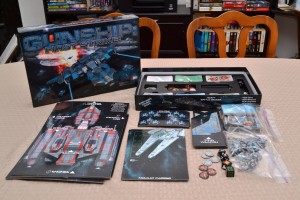
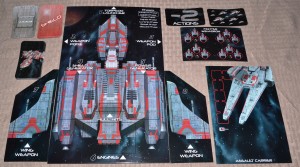
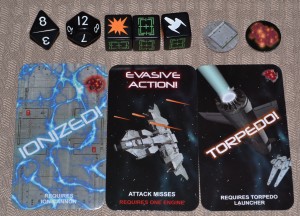
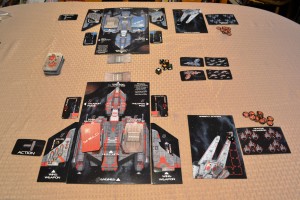
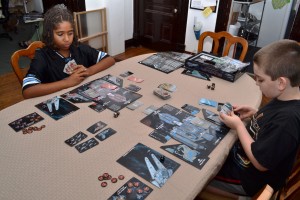
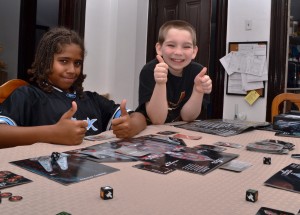
Hello,
I’m french, i’m ok with english language (plays ASL, satrfleet battles and a lot more) but I plan to buy this games for my children.
Are the cards heavily language dependant please ?
Or are they few different cards with icons ?
Thanks